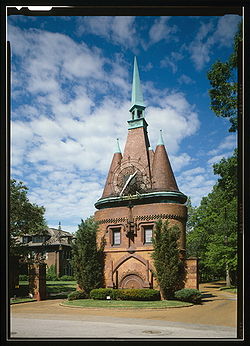
Washington Terrace (St. Louis)
Encyclopedia

Private place
A private place is a self-governing enclave whose common areas are owned by the residents, and whose services are provided by the private sector....
in St. Louis, Missouri
Missouri
Missouri is a US state located in the Midwestern United States, bordered by Iowa, Illinois, Kentucky, Tennessee, Arkansas, Oklahoma, Kansas and Nebraska. With a 2010 population of 5,988,927, Missouri is the 18th most populous state in the nation and the fifth most populous in the Midwest. It...
, laid out circa 1892. The gate is south of Union and Delmar, within the bounds of the Central West End
Central West End, St. Louis
The Central West End is an affluent neighborhood in St. Louis, Missouri, stretching from Midtown's western edge to Union Boulevard and bordering on Forest Park with its outstanding array of free cultural institutions. It includes the Cathedral Basilica of Saint Louis on Lindell Boulevard at...
.
A private place
Private place
A private place is a self-governing enclave whose common areas are owned by the residents, and whose services are provided by the private sector....
is a self-governing enclave whose common areas like streets and common gardens are owned by the residents, with services are provided by the private sector, an experiment that foreshadowed the gated community
Gated community
In its modern form, a gated community is a form of residential community or housing estate containing strictly-controlled entrances for pedestrians, bicycles, and automobiles, and often characterized by a closed perimeter of walls and fences. Gated communities usually consist of small residential...
in the U.S. by 100 years. About 50 of these enclaves once stood within the borders of the city of St. Louis. Most were designed by civil engineer Julius Pitzman
Julius Pitzman
Julius Pitzman was a Prussian-born American surveyor and city planner best known for his development of the private, gated neighborhoods in St. Louis, Missouri from 1867 through about 1914....
between 1868 and 1905. Many of these developments, like Washington Terrace, are well-preserved and still gated, patrolled, and functioning as private enclaves.
Pitzman laid out Washington Terrace with 50 lots and an imposing entry gate, a "French Norman Clock Tower" designed by Harvey Ellis
Harvey Ellis
Harvey Ellis was an architect, perspective renderer and painter. He worked in Rochester, New York; Utica, New York; St. Paul, Minnesota; Minneapolis, Minnesota; St. Joseph, Missouri; St...
and the architect George R. Mann
George R. Mann
George Richard Mann was a United States architect whose designs included the Arkansas State Capitol...
. The styles of the mansions, many of them built in anticipation of the 1904 Louisiana Purchase Exposition
Louisiana Purchase Exposition
The Louisiana Purchase Exposition, informally known as the Saint Louis World's Fair, was an international exposition held in St. Louis, Missouri, United States in 1904.- Background :...
and constructed atop substantial pedestals, range from Italian Renaissance, Richardsonian Romanesque and Tudor.
Number 25 Washington Terrace, for instance, was the residence of Joseph W. Moon, of St. Louis's once-successful Moon Motor Car
Moon Motor Car
Moon Motor Car was a United States automobile company that was based in St. Louis, Missouri. The company had a venerable reputation among the buying public, as it was known for fully assembled, easily affordable mid-level cars using high-quality parts...
. Number 11 was the home of Julius Adler Baer, of Stix, Baer and Fuller.

